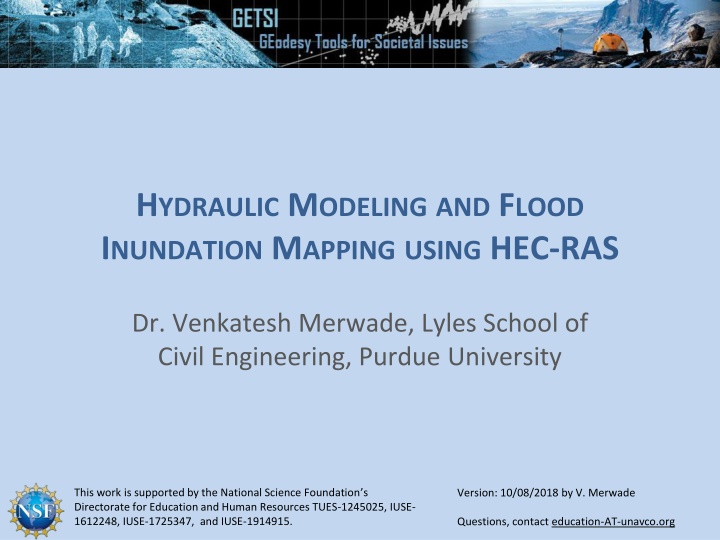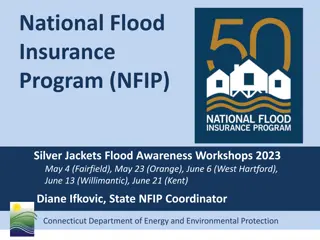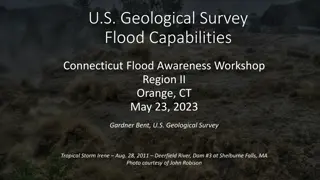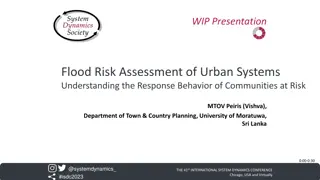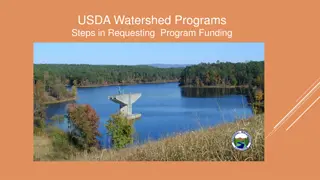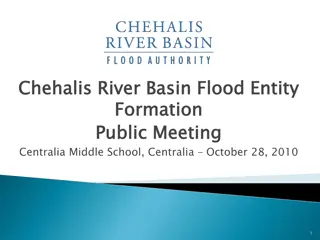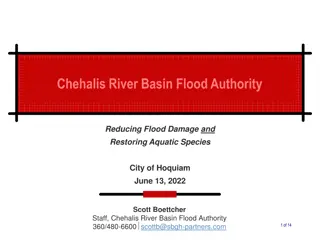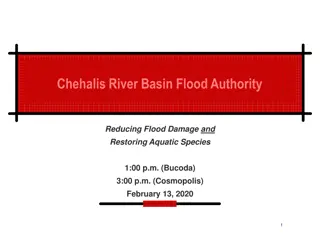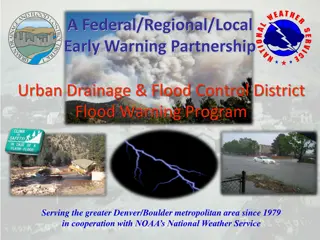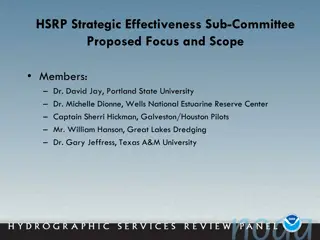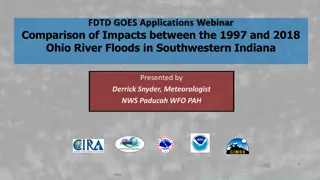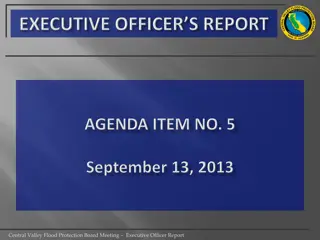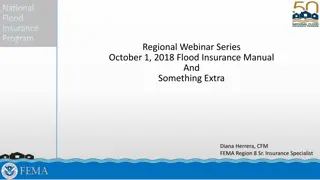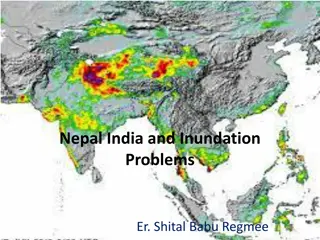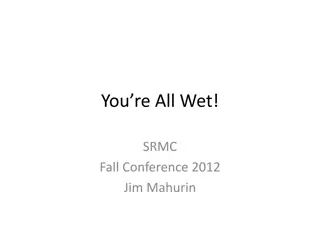Hydraulic Modeling and Flood Inundation Mapping
A hydraulic model represents water systems and analyzes their hydraulic behavior. It helps in understanding system behavior across different scenarios, scales, and dimensions. Different types of hydraulic models include 1D, 2D, and 3D models, each serving specific purposes. One-dimensional (1D) hydraulic models like HEC-RAS 1D focus on flow in one direction, useful for steady or unsteady riverine systems. These models solve governing equations to determine water surface elevation, velocity, discharge, and more at discrete cross-sections.
Download Presentation

Please find below an Image/Link to download the presentation.
The content on the website is provided AS IS for your information and personal use only. It may not be sold, licensed, or shared on other websites without obtaining consent from the author.If you encounter any issues during the download, it is possible that the publisher has removed the file from their server.
You are allowed to download the files provided on this website for personal or commercial use, subject to the condition that they are used lawfully. All files are the property of their respective owners.
The content on the website is provided AS IS for your information and personal use only. It may not be sold, licensed, or shared on other websites without obtaining consent from the author.
E N D
Presentation Transcript
HYDRAULIC MODELING AND FLOOD INUNDATION MAPPING USING HEC-RAS Dr. Venkatesh Merwade, Lyles School of Civil Engineering, Purdue University This work is supported by the National Science Foundation s Directorate for Education and Human Resources TUES-1245025, IUSE- 1612248, IUSE-1725347, and IUSE-1914915. Version: 10/08/2018 by V. Merwade Questions, contact education-AT-unavco.org
WHAT IS A HYDRAULIC MODEL? Hydraulic model: A hydraulic model is a mathematical representation of a water/sewer/storm system and is used to analyze the system s hydraulic behavior. Hydraulic modeling is frequently used to understand a hydraulic system s behavior under different scenarios at different spatial and temporal scales. Lab experiment Modeling Cost Time 2
DIFFERENT TYPES OF HYDRAULIC MODELS Hydraulic models can be categorized by dimensionality 1D 2D Flow is considered one dimensional (1D) both in channel and floodplain Flow is considered two dimensional (1D) in both channel and floodplain 3D 1D/2D Flow is considered three dimensional (3D) in both channel and floodplain Combined 1D-2D. 1D in channel and 2D in floodplain 3
ONE DIMENSIONAL (1D) HYDRAULIC MODEL A 1D model assume flow in one direction generally along the river. Flow along lateral direction is neglected Flow along longitudinal direction 1D EXAMPLES HEC-RAS 1D (Hydraulic Engineering Center-River Analysis Service 1D Model) MIKE 11 SWMM (Storm and water management model) HY8 4
HEC-RAS 1D Developed by U.S. Army Corps of Engineering River centerline, banks and cross- sections need to be defined. It can be used for the following situations: Steady or unsteady riverine systems Flow primarily along one direction Minimal split flow Calculations are conducted between different two contingent cross sections 5
GOVERNING EQUATIONS 1D hydraulic models elevation (WSE) and velocity at discrete cross-sections by solving a full version of 1D Saint-Venant equations using implicit finite difference method. compute cross-sectional average water surface A: cross-sectional area, Q: Discharge, S: frictional slope, z: water depth, x: distance along the flow, f: fraction to determine channel versus floodplain discharge, t: time 6
1D PROFILE CALCULATIONS 1 2 Plan View Longitudinal view he: head loss, V: velocity, g: gravitational acceleration, L: reach length, a: velocity coefficient 7
LOSS IN ENERGY HEAD LC LLOB LROB Plan View 2 ???? 2? ??2 2? 2 ???? 2? a?2 2? C: contraction/expansion coefficient. Contraction occurs when downstream velocity head is higher and vice versa. Cross-sectional View 8
FLOW CONVEYANCE AND FRICTIONAL SLOPE Computation of flow conveyance (K) and frictional slope (Sf) is based on Manning s n values. Thus Manning s n or roughness coefficient plays a critical role in hydraulic modeling. 9
PUTTING IT ALL TOGETHER Y1 is given. Assume Y2 Based on Y1 and Y2, compute conveyance (K) and friction slope (Sf), and then get he. Use he to compute Y2. If the error between computed Y2 and assumed Y2 is greater than a specified tolerance (e.g., 0.01 ft), iterate Y2 until the error is within tolerance. If the difference between computed Y2 and assume Y2 is within the specified tolerance, Y2 becomes Y1 and the computations move upstream. 10
DATA REQUIREMENTS River Channel description Length and slope the reach Channel and floodplain roughness Cross-section geometry Boundary Conditions Flow and/or stage data at upstream and downstream locations Structure geometry Bridges Culverts Weirs Levees, etc
GETTING RIVER DESCRIPTION A Digital Elevation Model (DEM) or Triangulated Irregular Network (TIN) is needed to extract cross-sections for HEC-RAS 12
GEOMETRY DATA PLAN VIEW Cross-section Bank locations Station number River or stream Junction
GEOMETRY DATA: CROSS SECTIONAL VIEW Elevation values along XS Station or distance along XS
STEADY FLOW DATA: UPSTREAM BOUNDARY CONDITION Flow value is specified at the upstream of each reach. Multiple values can be specified to create multiple profiles.
STEADY FLOW DATA: DOWNSTREAM BOUNDARY CONDITION Water depth (known water surface elevation, critical depth, or normal depth) can be provided as downstream boundary for each reach
RUNNING SIMULATION AND VIEWING RESULTS Steady flow analysis editor Profile view of results Cross-sectional view XYZ view
HEC-RAS LAB You are provided with a HEC-RAS model for Wabash-Tippecanoe confluence in West Lafayette, IN Run the model for different return periods ranging from 2- to 500-year and create flood inundation maps using RAS Mapper All instructions are provided in the handout
